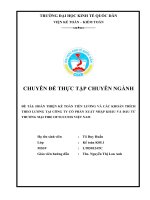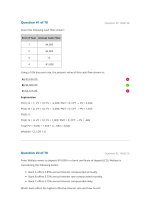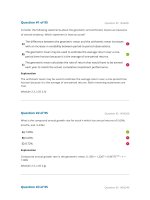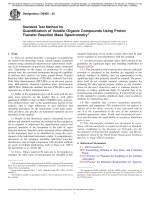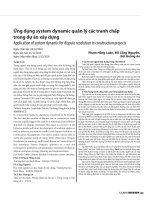Doctoral thesis of philosophy cross‐border mergers acquisitions by chinese multinational corporations performance, determinants and moderating factors
Bạn đang xem bản rút gọn của tài liệu. Xem và tải ngay bản đầy đủ của tài liệu tại đây (3.53 MB, 425 trang )
CROSS‐BORDER MERGERS & ACQUISITIONS BY CHINESE MULTINATIONAL CORPORATIONS:
PERFORMANCE, DETERMINANTS AND MODERATING FACTORS
A thesis submitted in fulfilment of the requirements for the degree of Doctor of Philosophy
Shijia Zhou
B. Ec., MBA, MPAcc, MFA
School of Management
College of Business
RMIT University
October 2014
CROSS-BORDER MERGERS & ACQUISITIONS
BY CHINESE MULTINATIONAL
CORPORATIONS:
PERFORMANCE, DETERMINANTS AND
MODERATING FACTORS
A thesis submitted in fulfilment
of the requirements for the degree of
DOCTOR OF PHILOSOPHY
by
Shijia Zhou
B. Ec., MBA, MPAcc, MFA
School of Management
College of Business
RMIT University
October 2014
DECLARATION
I certify that except where due acknowledgement has been
made, the work is that of the author alone; and the work has not
been submitted previously, in whole or in part, to qualify for any
other academic award; the content of the thesis is the result of
work which has been carried out since the official
commencement date of the approved research program; any
editorial work paid or unpaid, carried out by a third party is
acknowledged; and, ethics, procedures and guidelines have
been followed.
Signed:
i
ACKNOWLEDGEMENTS
The journey of undertaking this thesis has become one of the most extraordinary
experiences as well as charming memories in my life. Progressively reaching the gate
of PhD, I realised the intellectual challenge, the emotional stress and solitary life while
undertaking this thesis were worthwhile. Particularly, I am deeply appreciative and
grateful to my respected supervisors, dear friends and lovely family, who have
accompanied, motivated, encouraged and supported my journey to achieve this dream.
My deepest gratitude and thanks go to my supervisors, Dr Xueli Huang and Professor
Adela McMurray. Dr Huang is a responsible, polymath and warm-hearted supervisor
who has played an enormous role in my study as well as personal development. His
vast expertise in the field of Chinese overseas investment and critical advice in
designing, structuring and analysing this thesis is invaluable. I am always feeling
extremely lucky and honoured to be his student. Prof. Adela is an elegant, experienced
and detail-oriented supervisor who has encouraged, supported and motivated me to
keep working hard all the time. Her excellent comments and professional feedback on
this thesis significantly enriched its quality. To be their student, I greatly enjoyed the
close cooperation and will cherish every moment we spent together.
My appreciation also goes to other colleagues, who have provided their outstanding
support on my study and also thesis development. In particular, I would like to thank Dr.
Rui Bi and Miss Dashi Zhang. They contributed valuable time, knowledge and effort
during the substantial case coding period. Additionally, I would like to thank Professor
Chi Renyong, who has provided deep support through the interview period in
Hangzhou China. Furthermore, I would like to express my gratitude to Dr. Ling Deng,
who kindly helped my study and guide my research process at early beginning. I also
extend my thanks to Graeme Kemlo for his professional editorial contributions and
valuable support in delivering a quality thesis.
ii
My thanks also go to school of management, RMIT University. Its generous financial
support enabled me to concentrate on the study.
Finally, I deeply thank my family members who have shared their care and love to me
during the study. Thank you my mother, Fengjuan Sun, for your support, sacrifice and
contribution of your maternal love to me. Thank you my brother, Qianmao Sheng, who
provided financial support for my study. Thank you, Hua Bai, for your understanding,
encouragement and wholehearted support throughout my study.
Fortune favours the bold.
- Alexander the Great (356-323 BC)
iii
DEDICATION
I dedicate this thesis to:
My mother Fengjuan Sun
My brother Maosheng Qian
For your constant support, encouragement and unconditional
love throughout my life.
iv
TABLE OF CONTENTS
Page
DECLARATION
I
ACKNOWLEDGEMENTS
II
DEDICATION
IV
TABLE OF CONTENTS
V
LIST OF TABLES
XII
LIST OF FIGURES
XIV
LIST OF ACRONYMS
XVI
ABSTRACT
XVII
1
CHAPTER 1 INTRODUCTION
1.1 Background
1
1.2 Research questions and objectives
6
1.3 Outline of the thesis
8
1.4 Summary
10
CHAPTER 2 LITERATURE REVIEW
11
2.1 Introduction
11
2.2 Definition and justification of CBMA concept
12
v
2.3 Review of CBMA studies
14
2.3.1 Conventional theoretical perspectives on Western CBMA research
22
2.3.2 Contemporary CBMA research: current theoretical development
39
2.3.3 Context-free and context-embedded considerations in Chinese CBMA
research
44
2.4 Research methodology in CBMA studies
46
2.4.1 Consideration of method design in CBMA research
46
2.4.2 Review of case-survey approach in CBMA research
54
2.5 Limitations of previous CBMA research
58
2.6 Summary
60
CHAPTER 3 DEVELOPMENT OF AN INTEGRATIVE CBMA
FRAMEWORK AND HYPOTHESES
3.1 Introduction
61
61
3.2 Development of an integrative conceptual framework and
hypotheses
62
3.2.1 Theoretical background
62
3.2.2 The proposed integrative model of Chinese CBMA
70
3.2.3 Concept definitions of constructs
72
3.2.4 Development of hypotheses
76
vi
3.3 Development of measurements for the constructs
86
3.3.1 Dependent variables
87
3.3.2 Independent, moderating and control variables
89
3.4 Summary
97
CHAPTER 4 RESEARCH METHODOLOGY
4.1 Introduction
99
99
4.2 Research Design
100
4.2.1 Quantitative method selection consideration and case-survey
103
4.2.2 Qualitative method selection consideration and multiple case study
105
4.2.3 Sampling frame and considerations
106
4.3 Case-survey design
111
4.3.1 Step One: Developing case selection criteria
113
4.3.2 Step Two: Collecting cases materials and constructing case samples
114
4.3.3 Step Three: Designing a detailed coding scheme
118
4.3.4 Step Four: Using multiple raters to code case samples
119
4.3.5 Step Five: Measuring interrater reliability and resolving coding
discrepancies
121
4.3.6 Step Six: Quantitative analysis of the coded quantitative data
4.4 Case study design
125
127
vii
4.4.1 Multiple case study design
127
4.4.2 Data collection
131
4.4.3 Data analysis
136
4.4.4 Quality of case study research
140
4.5 Summary
143
CHAPTER 5 CASE-SURVEY ANALYSIS AND FINDINGS
144
5.1 Introduction
144
5.2 Demographic characteristics of samples
144
5.2.1 Geographic distribution analysis
145
5.2.2 Historical distribution analysis
147
5.2.3 Industrial distribution analysis
150
5.3 Hypotheses testing and discussions
153
5.3.1 Pearson correlation coefficients
153
5.3.2 Hypotheses testing
156
5.4 Findings and discussions
168
5.4.1 Main hypotheses
168
5.4.2 Moderated hypotheses
173
5.5 Summary
177
viii
CHAPTER 6 CASE STUDY ANALYSIS AND FINDINGS
179
6.1 Introduction
179
6.2 Case Study One: Lenovo’s acquisition of IBM PCD
180
6.2.1 Case background
180
6.2.2 Case findings and discussions
181
6.2.3 Case Summary
196
6.3 Case Study Two: Geely’s acquisition of Sweden Volvo
198
6.3.1 Case background
198
6.3.2 Case findings and discussions
199
6.3.3 Case summary
216
6.4 Case Study Three: Wanxiang’s acquisition of Ford’s driveshaft
business
219
6.4.1 Case background
219
6.4.2 Case findings and discussions
221
6.4.3 Case summary
228
6.5 Cross-case analysis and discussion
231
6.5.1 Strategic combination benefits and Chinese CBMA
231
6.5.2 Organisational integration and Chinese CBMA
234
6.5.3 Cultural resistances and Chinese CBMA
238
ix
6.5.4 Ownership and firm-specific resources and competences with Chinese
CBMA
242
6.6 Summary
244
245
CHAPTER 7 CONCLUSION
7.1 Overview
245
7.2 Conclusions
246
7.2.1 Crucial factors influence the performance of Chinese CBMA
247
7.2.2 Other factors influence the performance of Chinese CBMA
250
7.3 Contributions and implications
252
7.3.1 Theoretical contributions
252
7.3.2 Practical implications
254
7.4 Limitation and recommendations for future research
258
REFERENCES
261
APPENDICES
299
Appendix 1 The steps of conducting case-survey research
299
Appendix 2 The complied list of Chinese CBMA deals
308
Appendix 3 The summary of data sources and specific databases used in
screening the case samples
323
Appendix 4 The summary of collected case samples, sources and references
324
x
Appendix 5 The list of detailed references for case samples
339
Appendix 6 The summary of searching strategies and sources for collected
eligible cases
348
349
Appendix 7 Coding scheme
Appendix 8 Invitation letter and information distributed to interviewees (in
English and Chinese)
361
367
Appendix 9 Interview protocol
Appendix 10 Geographic distribution of Chinese OFDI stock, case samples
and Chinese CBMA deals
373
Appendix 11 Historical distributions of case samples and Chinese CBMA
deals
375
Appendix 12 Industry distributions of case samples and Chinese CBMA deals
376
Appendix 13 Case One: background of Lenovo’s acquisition of IBM PCD 377
Appendix 14 Case One: summary of the interview record
382
Appendix 15 Case Two: background of Geely’s acquisition of Volvo
383
Appendix 16 Case Two: cost control and benefit in JVs
389
Appendix 17 Case Three: background of Wanxiang Group and its CBMA 390
Appendix 18 Case Three: cultural resistances and cost control strategy 401
Appendix 19 The list of author’s publications from this thesis
xi
403
LIST OF TABLES
Page
Table 2.1 The reviewed journals and M&A articles (Jan 1990 – June 2014) 15
Table 2.2 Summary of the research groups, issues, central propositions,
references and frequency counts in 215 leading articles
Table 2.3 The distribution of research methods in 215 articles
16
47
Table 3.1 The summary of theoretical and operational definitions of coding
items and variables
91
Table 4.1 The results of screening Chinese CBMA deals by Zephyr database
110
Table 4.2 Four databases for matching the screened deals
111
Table 4.3 The summary of working loads and contributions for three raters 121
Table 4.4 The results of APPA across three raters
123
Table 4.5 The summary of coding resolution analysis
125
Table 4.6 The summary of case information, profile of interviewees and
information for interviews
134
Table 4.7 Strategies and criteria to improve trustworthiness
141
Table 5.1 T-test: the comparison of key variables before 2009 and after 2009
149
Table 5.2 ANOVA test: the results for key variables on three industrial groups
152
Table 5.3 Pearson correlation coefficients of main variables (N=55)
xii
155
Table 5.4 The results of Hierarchical regression analyses
157
Table 5.5 T-test: the comparison of key variables between SOEs and POEs161
Table 5.6 The results of hypotheses testing: main hypotheses
169
Table 5.7 The results of hypotheses testing: moderating hypotheses
(institutions)
174
Table 5.8 The results of hypotheses testing: moderating hypotheses
(Organisational resources and competences)
Table 6.1 The integration process of Lenovo’s acquisition of IBM PCD
176
184
Table 6.2 The summary of process, objectives and major activities of cultural
integration
189
Table 6.3 The summary of strengths and weaknesses between Geely and
Volvo
201
Table 6.4 The summary of JVs activities between Geely and Volvo
208
Table 6.5 The summary of employed consulting firms and their roles
213
Table 6.6 Cross-case analysis: strategic combination benefits
232
Table 6.7 Cross-case analysis: organisational integration
236
Table 6.8 Cross-case analysis: cultural resistances and integration
240
xiii
LIST OF FIGURES
Page
Figure 1.1 The comparative historical value between China’s OFDI and CBMA
between 2001 to 2013 (in million US dollars)
2
Figure 3.1 The context-free model and its linkage with strategic management
concept
65
Figure 3.2 The context-embedded factors and moderating effects
68
Figure 3.3 An integrative framework of Chinese CBMA performance
71
Figure 4.1 A two-stage research design
103
Figure 4.2 The relationship between OFDI and majority control of related CBMA
108
Figure 4.3 The six steps of conducting case-survey research
113
Figure 4.4 The strategies for collecting case materials
115
Figure 5.1 The comparison of geographic distribution between case samples
and population
145
Figure 5.2 The comparison of historical distribution between case samples and
population
147
Figure 5.3 The comparison of industrial distribution between case samples and
population
151
Figure 5.4 The results of multiple regression analysis
158
Figure 5.5 The moderating effect of institutions on the cultural resistances–
Chinese CBMA performance relationship
xiv
164
Figure 5.6 The moderating effect of organisational resources and competences
on the organisational integration–Chinese CBMA performance
relationship
167
Figure 5.7 The relationships of three antecedents with Chinese CBMA
performance
172
Figure 6.1 The dynamic process of post-transaction integration
194
Figure 6.2 The slow and partial touch integration process
204
Figure 6.3 A two-way process of technological transfer between Wanxiang and
acquired business
225
xv
LIST OF ACRONYMS
APPA
Average Pairwise Percent Agreement
CMAA
China Mergers & Acquisitions Association
OEM
Original Equipment Manufacturer
OFDI :
Outward Foreign Direct Investment
CBMA :
Cross-Border Mergers and Acquisitions
CR :
Cultural resistances
GFC :
Global Financial Crisis
IFDI :
Inward Foreign Direct Investment
JV :
Joint Venture
MNCs :
Multinational Corporations
MOFCOM :
China’s Ministry of Commerce
OI :
Organisational Integration
POEs :
Private Owned Enterprises
RBV :
Resource-Based View
SASAC
State-Owned Assets Supervision and
Administration Commission
SCB :
Strategic Combination Benefits
SOEs :
State Owned Enterprises
xvi
ABSTRACT
Chinese Cross-Border Mergers & Acquisitions (CBMA) have accounted for a majority
of Chinese outward foreign direct investment (OFDI) and thus received much academic
attention in recent years. Along with China’s integration with global economies,
thousands of Chinese companies have become Multinational Corporations (MNCs).
Equipped with little internationalisation experience and resources, Chinese MNCs not
only struggle to survive in the intense global competition, but also hunt for new
opportunities in the global market. Prior literature showed that Chinese MNCs have
faced many problems and challenges, particularly in their M&A, being latecomers.
However, extant research is limited in understanding their behaviours and activities,
and scarce in developing theories to explain Chinese CBMA performance.
Much existing literature in Chinese CBMA has concentrated on the pre-transaction
analysis, motives, entry mode selection, and geographical distribution. Little effort so
far has been devoted to the understanding of the post-transaction performance of
Chinese CBMA, and its crucial antecedents and moderating factors. This thesis aims to
address these gaps and contribute to the existing M&A theories through the
development of an integrative conceptual framework by bridging the conventional
‘context-free’ theories developed from Western economies’ CBMA and specific
‘context-embedded’ factors in Chinese CBMA. The conceptual framework developed
in this thesis attempted to explain Chinese CBMA performance by the use of three
crucial antecedents, strategic combination benefits, organisational integration and
cultural resistances, and two moderating factors (firm’s ownership and resources and
competences), and test their relationships to performance.
Given the specific research questions, this thesis employs a two-stage approach with the
explicit objectives of testing the proposed conceptual framework and then further
exploring a more detailed explanation of these mechanisms. Therefore, a combination
xvii
of a predominated case-survey approach, which comprehensively examines the large
volume of in-depth case studies, and a supplemented multiple case studies approach has
been adopted. More specifically, the primary case-survey study, which was marked as
the ‘powerful’ approach in the literature, aims to provide an empirical evaluation of the
major determinants of Chinese CBMA performance, and how these relationships are
moderated by Chinese MNCs’ unique contextual factors, that is, the types of ownership,
resources and competences of Chinese MNCs. A conventional multiple case studies
approach was followed. It aimed to supplement the findings from the case-survey,
provide additional insights to Chinese CBMA and enhance the understanding of how
these mechanisms impact performance.
Both case-survey and multiple case studies research has been designed to reflect the
academic rigour and research objectives. Firstly, a list of Chinese CBMA deals was
compiled, based on the following three research criteria: the Chinese CBMA deal (1)
was completed between 2000 and 2012, (2) reflected the fact that Chinese MNCs
controlled more than 50% of the shares of target firms, and (3) has the nature of related
CBMA. Several widely used M&A databases, Zephyr Global M&A, Thomson ONE
databases, and that developed by Heritage Foundation were accessed to develop the list.
A total of 205 Chinese CBMA deals have met research criteria and are covered in these
databases. This comprises the sampling frame for this study.
The materials relevant to these case samples were systematically collected from both
Chinese and English academic databases along with high quality and leading case
databases. Eligible case studies were then screened according to the rigorous selection
criteria: (1) that they contain at least two pages of case description in either Chinese or
English, and (2) cover the relevant perspectives in this study. Finally, a total of 55 case
samples with 191 references from multiple sources were compiled. Moreover, three
independent and competent raters in M&A have participated in the case coding with
guidance from the detailed coding scheme. The overall inter-rater reliability was 0.846
of Average Pairwise Percent Agreement, and any coding discrepancies were jointly
resolved by all raters. Hierarchical regression analysis has been adopted to test the
xviii
conceptual framework and developed hypotheses.
In the second stage of this thesis, which comprises multiple case studies, three cases of
Chinese CBMA were chosen. In this study, accessibility to the data is challenging as
Chinese CBMA are quite sensitive and Chinese executives tend not to publicly disclose
their opinions and inside information. With the help of a leading Chinese professor,
three leading and typical CBMA deals by Chinese Private Owned Enterprises (POEs)
have agreed to participate in this study. All cases match the relevant perspectives of this
study and contain significant and identifiable activities in post-transaction integration.
Within three cases, the primary data were collected from in-depth semi-structured
interviews with eight senior managers, who have participated in CBMA. A detailed
interview protocol was developed and used to guide these interviews. Moreover, a large
set of secondary data from several sources was also collected and used to achieve
triangulation for the findings. Both single- and cross-case analyses have been
performed for three case studies in order to provide detailed explanation of proposed
mechanisms in a real-life context and to explore additional insights into Chinese
CBMA.
The findings from case-survey research showed that five out of nine hypotheses were
supported. More specifically, it was found that Chinese CBMA performance is affected
by strategic combination benefits, organisational integration positively and cultural
resistances negatively. Additionally, the relationship between performance and cultural
resistances is moderated by Chinese MNC’s ownership, and the relationship between
the performance and organisational integration is moderated by the firms’ resources and
competences. Specifically, Chinese State Owned Enterprises (SOEs) show a stronger
moderating effect on the relationship of cultural resistances and performance compared
with Chinese POEs; and Chinese MNCs with better resources and competences present
a stronger moderating effect on the relationship between organisational integration and
the performance than those with low ones.
xix
Three single-case studies contributed additional evidence and detailed explanation of
the proposed mechanisms’ impact on Chinese CBMA performance and thus strengthen
the findings from the case-survey. More importantly, they provided a detailed account
of how these unique mechanisms affect the performance and further elaborate the
unique characteristics of Chinese CBMA, such as ownership, firm-specific resources
and competences and specific integration approaches. Cross-case analysis provided the
comparison of cross-case patterns and discussion of differences and similarities among
the three cases.
This thesis concluded with a summary of findings and their implications. The combined
findings from the case-survey and multiple case studies largely support the developed
integrative conceptual framework, which integrated Western CBMA’s ‘context-free’
theories with China’s ‘context-embedded’ factors. This has contributed to the theories
in M&A study. Moreover, multiple case studies extend the findings from the casesurvey and further contributed to an in-depth understanding of the Chinese CBMA
study. Finally, implications based on the findings and areas for future research were
outlined.
xx
Chapter 1
Introduction
CHAPTER 1
1
INTRODUCTION
1.1 Background
Along with the rapid development of China’s economy over the past three decades,
China’s outward foreign direct investment (OFDI) has continuously increased. By the
end of 2013, the stock of China’s OFDI has reached $613.5 billion and Chinese firms
have established over 22,000 foreign entities scattering in 179 countries (Li, Jiabao
2013; MOFCOM 2013; UNCTAD 2014b). According to the historical data, China’s
OFDI flow has boosted 35 times over the last decade increasing substantially from $2.8
billion in 2003 to $101 billion in 2013 (UNCTAD 2014a). China has become the third
largest OFDI source country in 2013 trailing USA and Japan (UNCTAD 2014a).
Moreover, several researchers predicted that Chinese OFDI would surpass inward
foreign direct investment (IFDI) in this decade (Alon, Fetscherin & Gugler 2011; Ding
& Bao 2011; UNCTAD 2010).
This emerging phenomenon of increasing Chinese OFDI in the world economy can be
explained by factors at both macro and micro levels. At the macro level, the Chinese
government has diversified its way of holding foreign bonds and encouraged Chinese
firms to invest abroad to build China as a true world-class economy (Globerman &
Shapiro 2009; Hout & Michael 2014). At the micro level, the accumulation of sufficient
knowledge and capital from decades’ internationalisation experience has allowed
Chinese multinational corporations (MNCs) to explore opportunities abroad.
Considering these macro and micro contexts, Buckley (2010) argues that ‘China has
become such an important element of the global economy that its influence cannot be
ignored in almost any field of endeavor’ (p.1). Therefore, the crucial role of Chinese
OFDI in the world economy should not be ignored. This new phenomenon of high level
Chinese OFDI is becoming an emerging research topic in international business study
(Alon, Fetscherin & Gugler 2011).
This phenomenal raise of China’s OFDI is significantly contributed by cross-border
Chapter 1
Introduction
2
mergers and acquisitions (CBMA) (Xia, J et al. 2014). According to the statistics from
China’s Ministry of Commerce (MOFCOM) (2011, 2012, 2013), CBMA have been
chosen as the primary expansion strategy adopted by Chinese MNCs. In 2013, Chinese
MNCs completed 288 CBMA with the total volume of $50 billion and accounted for
49.6% of total OFDI in 2012-2013 (UNCTAD 2014c). Figure 1 reports the comparative
historical data cross Chinese OFDI and CBMA.
120000
100000
80000
60000
40000
20000
0
2001 2002 2003 2004 2005 2006 2007 2008 2009 2010 2011 2012 2013
OFDI Flow
CBMA
Figure 1.1 The comparative historical value between China’s OFDI and CBMA
between 2001 to 2013 (in million US dollars)
Sources: UNCTAD (2014a, 2014c) and Statistical bulletins of China’s OFDI from MOFCOM
(2012, 2013)
Since China’s ‘go global’ policy introduced in 1999, Chinese MNCs started to venture
overseas (Huang, X & Chi 2014; Peng 2012). The booming of Chinese OFDI has
received much attention and even caused consternation around the world. Such
dramatic increase of Chinese OFDI provided both opportunities and challenges to the
academia (Cui, L & Jiang 2010; Zhou, S & Huang 2014). In the last decade, there is
increasing research on China’s OFDI (Alon, T 2010; Buckley 2010; Peng 2012; Taylor
2002; Xia, J et al. 2014), including its CBMA in the strategic management area (Chen,
Y. & Young 2010; Deng 2010; Lin et al. 2009; Ning et al. 2014). However, current
Chapter 1
Introduction
3
literature in Chinese CBMA is quite narrow because of (1) the short period of
observation (Liu, Xiaohui & Zou 2008), (2) the limited theoretical foundation to
explain important issues in the post-transaction integration stage (Buckley 2010), and
(3) the incomplete understanding of Chinese MNCs’ specific characteristics, such as
ownership and capabilities (Peng 2012).
CBMA are usually subject to uncertain risks and failures due to the high level of
unpredictability associated with strategic investment and operations (Bausch & Krist
2007; Gao, L et al. 2010). Commercial counsellor of MOFCOM, Mr. Chen Runyun
indicated that more than 11 per cent of Chinese CBMA failed compared with the failure
rate of two per cent in Western economies CBMA (Ma, L 2013). Moreover, Yang
(2010) pointed out that, although Chinese CBMA have rapidly been expanded in recent
decades, their post-transaction performances were not satisfactory. He revealed that,
‘some of these deals (Chinese CBMA) cannot achieve synergistic effect after
completing post-acquisition integration’ and were thus subject to financial loss (p.79).
Huang and Zhou (2012) evaluated the financial performance of Chinese investments in
Australia’s mining industry, and authors found that the majority of these investments
were conducted by large Chinese State Owned Enterprises (SOEs) while about twothirds of their financial performance were unsatisfactory. Therefore, both anecdotal
evidence and empirical research show that Chinese CBMA performance may differ
from China’s official scene of prosperity, and their post-transaction performances and
long term viability is questionable.
The vast differences between China and Western economies generate large theoretical
gaps that limit the understanding of what factors determine and influence Chinese
CBMA performance (Tan, H & Ai 2010). Compared with Western economies, China
has unique characteristics that are not shared with them (Zhou, N 2010; Hout &
Michael 2014). Several researchers (Buckley et al. 2007; Cai, KG 1999; Cui, L & Jiang
2010; Huang, X 2009; Moly 2011; Moon & Roehl 2001) pointed out that Chinese
CBMA have both a ‘conventional’ dimension and an ‘idiosyncratic’ dimension, and are
strongly affected by the institutional environment, policy liberalisation and Chinese
firms’ own resources and competence. However, currently the extant studies on
